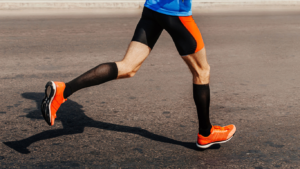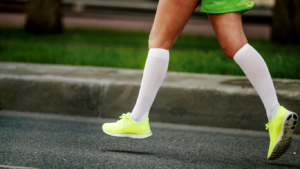Compression Garments
Why use them?
 One of the newest trends for recovery in the athletic market, is the use of compression clothing. So what is all the fuss really about? What is compression clothing? and What do I use compression garments for?
One of the newest trends for recovery in the athletic market, is the use of compression clothing. So what is all the fuss really about? What is compression clothing? and What do I use compression garments for?
Compression garments are a relatively new tool for athletes and research is currently being undertaken to determine all the true benefits.
What they seem to do is help both performance and recovery by:
Improving athletic performance by maintaining repeated jump performance – great for sports like AFL where repeated jumps in a game are crucial for keeping possession of the ball
Reducing muscle movement and vibration and focus the direction of the muscle- excellent for distance running or activities where there is a repeated movement pattern over-and-over again in order to reduce muscle fatigue from the vibrations and reduce the metabolic cost of running
 Maintaining body temperature and moisture wicking – particularly useful for keeping the body warm in colder environments and helping the body during warm-up. Surprisingly, the moisture-wicking ability allows these garments to evaporate sweat and also helps keep the athlete cool in hotter environments.
Maintaining body temperature and moisture wicking – particularly useful for keeping the body warm in colder environments and helping the body during warm-up. Surprisingly, the moisture-wicking ability allows these garments to evaporate sweat and also helps keep the athlete cool in hotter environments.
Assisting in the athlete’s psychological recovery from repeated bouts of exercise compared to passive recovery – obviously useful to perform well when the athlete needs to back-up in multiple games (ie. duirng Touch Footy carnivals) or for multiple events (ie. Swimming championships)
Reducing the time taken for muscles to repair themselves by altering muscle metabolites and swelling produced during exercise and also reducing muscle soreness during post workout recovery following eccentric (muscle lengthening) exercise – almost every competitive sports involves eccentric muscle contractions so this suggests compression garments are excellent for helping muscles recover to a more normal state, and faster, following sport
They may also be an alternative to Compression stockings worn during long flights to reduce the risk of Deep Vein Thrombosis (DVT) caused by pooling of blood in the lower legs
They provide support to help keep male genitalia in place, are great under short skirts (such as womens hockey) to avoid exposing underwear and help reduce chaffe between the legs when running.
Why should I use compression garments?
A compression garment is a form-fitting garment that athletes wear for a number of reasons of performance benefit (see below). They are usually made of a combination of Nylon and Lycra so that they provide a firm compression to the limb/body part over which they are worn.
Examples include: long ankle-length tights, knee-length shorts, full-length arm shirts, tee-shirts, singlets, calf-guards (covering just the shank-region and are used by many runners), calf-guards with stirrups around the feet (perfect for soccer/hockey/football or sports where shin guards need to be kept in place or for orienteering) and socks.
Compression Garments may have many benefits and I would recommend them to any sportsperson or even social competitors who don’t like feeling sore after exercise. All you need is one garment and they do last a long time!
I personally wear long compression tights for the duration of an event when I’m competing in long distance running and long adventure racing. I also wear my long tights immediately after (and I even sleep in them) if I am particularly sore from a training session or race, or when I need to back up racing from one day to the next. And I wear my calf guards for Orienteering or Rogaining as they provide both compression benefits and act as a very light-weight leg protector.
We stock variuos compression garments, please visit Ashmore or Burleigh Clinics or call us 07 5500 6470
Yours in Good Training,
Britt Caling APA Titled Sports & Exercise Physio, Gold Coast Physio & Sports Health

































